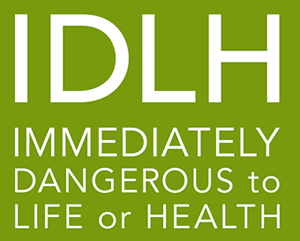Immediately Dangerous To Life or Health (IDLH) Values

Overview
Occupational exposures to chemicals have long been recognized as having the potential to adversely affect the lives and health of workers. Acute or short-term exposures to high concentrations of some airborne chemicals have the ability to quickly overwhelm workers, resulting in a wide spectrum of undesirable health outcomes that may include irritation of the eyes and respiratory tract, severe irreversible health effects, impairment of the ability to escape from the exposure environment, and, in extreme cases, death.
The Immediately dangerous to life or health air concentration values (IDLH values) developed by the National Institute for Occupational Safety and Health (NIOSH) characterize these high-risk exposure concentrations and conditions and are used as a component of respirator selection criteria first developed in the mid-1970s. IDLH values are established (1) to ensure that the worker can escape from a given contaminated environment in the event of failure of the respiratory protection equipment and (2) to indicate a maximum level above which only a highly reliable breathing apparatus, providing maximum worker protection, is permitted.
Since the development of the original IDLH values in the 1970s and their subsequent revision in 1994 (NIOSH Documentation for Immediately Dangerous to Life or Health Concentrations (IDLH) (1994))pdf icon. NIOSH has continued to review relevant scientific data and conduct research on methods for developing acute exposure guidelines.
For more information about the development of IDLH values, refer to NIOSH Current Intelligence Bulletin 66: Derivation of Immediately Dangerous to Life or Health Values (DHHS (NIOSH) Publication Number 2014-100).
